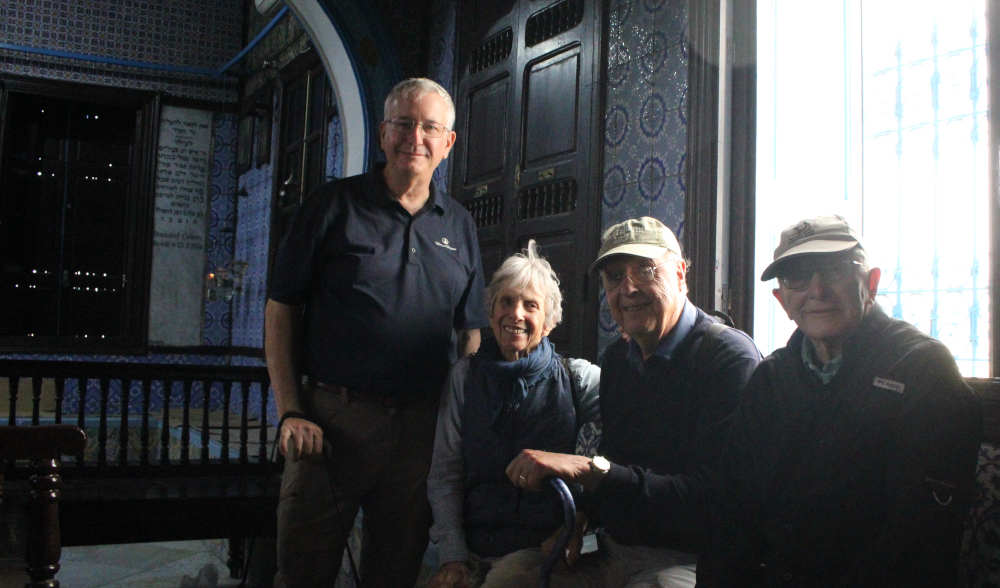

UPDATE: DOCUMENTING PLURALISTIC CULTURAL HERITAGE IN DJERBA, TUNISIA
By Safouane Tlili | Senior Technician for Carthagina and ASOR Implementing Partner
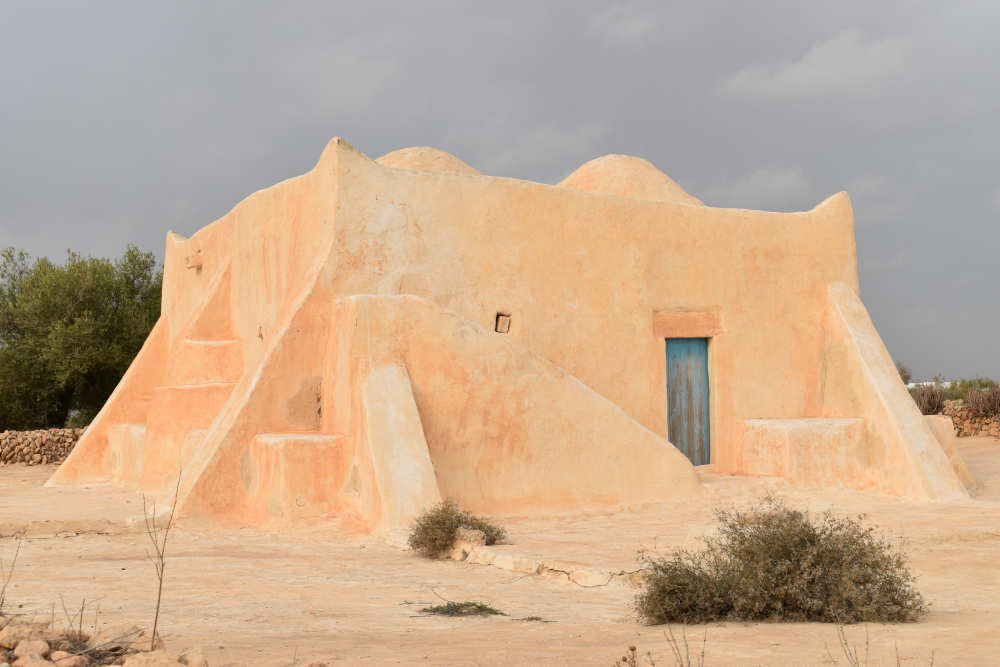
The al-Jadid Mosque is built with thick walls like a fortress
The Tunisian island of Djerba is well known among tourists as the island of dreams and of lotus-eaters. Less famous are the many magnificent mosques—it should also be known as “the island of mosques.”
As soon as you step on the island, a mosque appears, calling you from afar with its spotless whiteness and the beautiful sound of the call to prayer. Although there are many Hanbali and Maliki sects of Islam represented in Djerba—and this is clear from the shapes of minarets—the majority and the oldest mosques on the island belong to the Ibadi sect, with its two divisions: the Wahhabi and the Mustawiya/Nakariyya.
The Ibadis of Djerba, known for their architectural expertise and their military defense systems, prepared for outside attacks by establishing a series of mosques or watchtowers along the entire coast of the island. These structures acted as much as castles or fortresses as worship structures. In addition to being a line of defense, they provided refuge for the community during the many battles that the Ibadis fought over time.
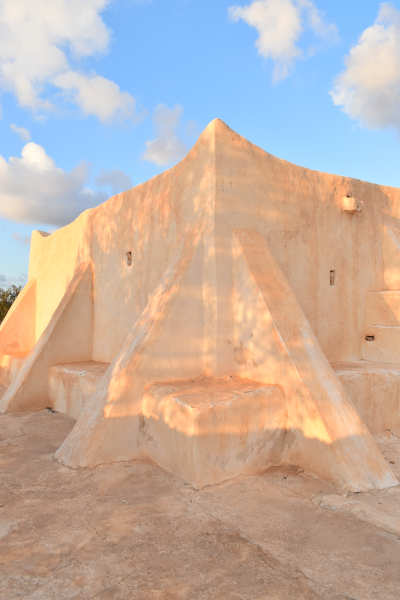
Buttresses of the al-Jadid Mosque are visible on the outer facades
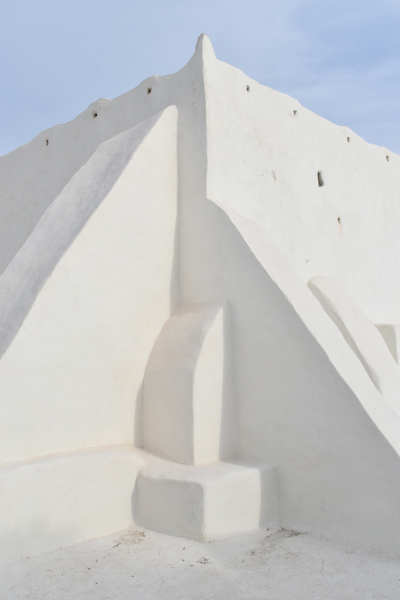
White walls of the Fadloun Mosque were restored recently
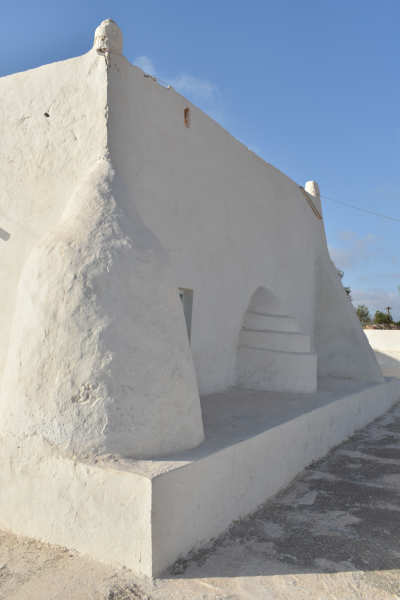
Ibadi Mosque painted in white in Bedwin
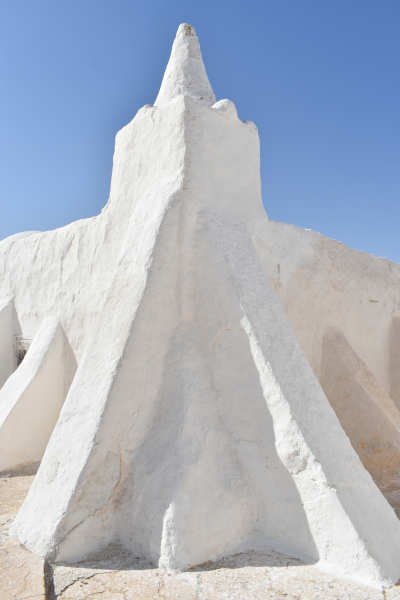
The minaret of Ouled Hlal Mosque in Meidoun
Indeed, women and children of the community found refuge in these mosques during periods of conflict. The Ibadis developed a 5-tiered defense system that was critical to their military success. Mosques formed the first line of defense, from which warning signals were communicated to one another by beating drums and lighting bonfires. Because of their defensive role, Ibadi mosques were solidly built, including thick walls, sills, and latches for pouring hot water and oil onto combatants. A few notable mosques are Sidi Yati in Guellala, Sidi Jamour, Sidi Salem, Sidi Zayed, Al-Qomeyr, Al-Hajar, Al-Hara, and Warsegen.
The inhabitants of Djerba used the many twisted, long, and similar-looking valleys to trap the enemies as part of the second tier of defense. The would-be invaders, especially those who were not familiar with the landscape, would get lost and be open to counter-attacks. These valleys acted like a maze from which there was no way out, allowing the Ibadis to easily trap and defeat their enemies.
The third line of defense was made of high earthen berms that were raised and planted with prickly cacti. Behind the berms were Ibadi dwellings (4th tier) known as Ahwash (enclosures). Ahwash were small square castles built with thick walls and combat openings, which protected water sources from outside use (5th tier). This strategy helped them defeat their invaders and annihilate them from thirst. Mosques in Djerba were built as part of a larger defense system and inter-connected web of communication, which played a prominent role in the Ibadi’s security for many centuries starting in the 7th century C.E.
In summary, a unique aspect about the mosques of Djerba is that they were built according to a well-thought-out architectural plan. They were constructed as a “spider’s web,” systematically connecting all the mosques and spreading across the island. This network of mosques enabled the Ibadis to be ready to face any danger or invasion.
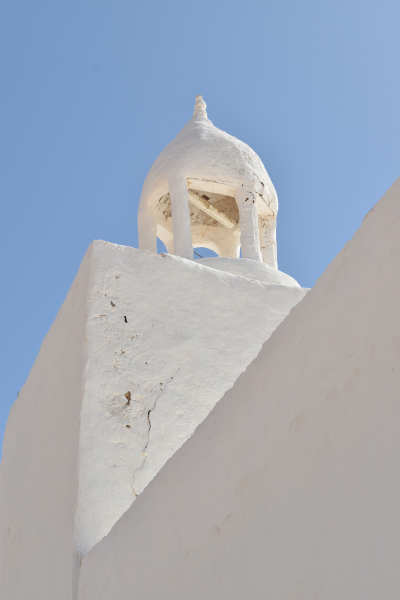
The low height of minarets in Ibadi mosques conferred protection
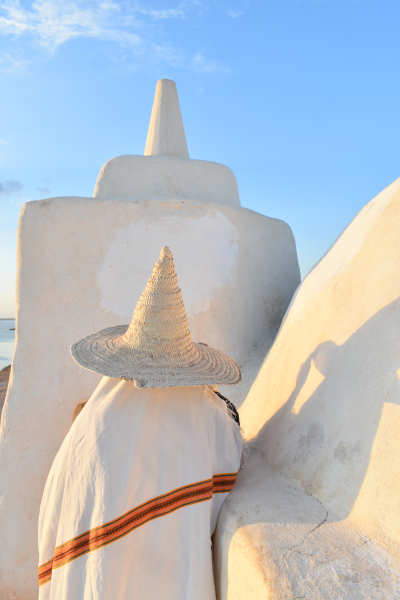
The shape of the traditional Djerbian woman straw hat and the Ibadi minaret offer perfect symbiosis
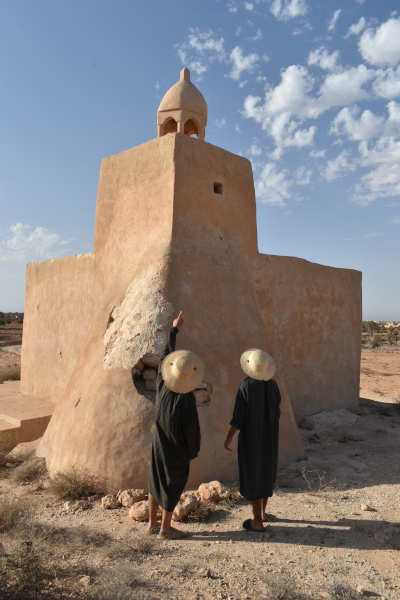
Men in traditional Djerbian clothes at the al-Ghoula Mosque
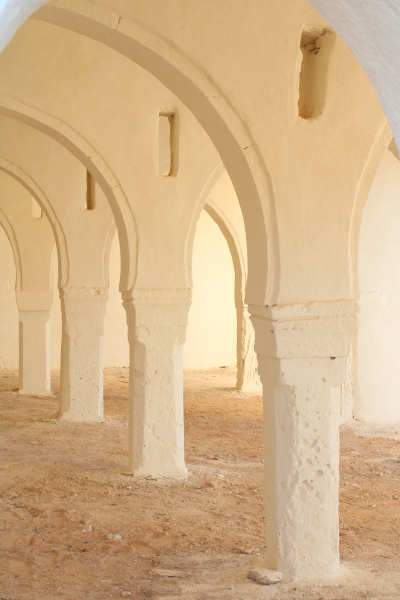
Outdoor praying area at the Welhi Mosque
Ibadi mosques served as educational centers in addition to their military roles. Mosques such as those of Walhi in Jaabira, Al-Bardawi in Al-Gerea, Boumsur in Al-Hashan, and Al-Hara Bursigin were scientific beacons and produced many renown scholars. Mosques played other social roles, most notably in judicial matters. Activities associated with the mosque included (1) providing services to women, (2) dealing with local grievances, (3) finalizing marriage contracts, and (4) distributing water (each mosque was surrounded by cisterns for storing rainwater).
Mosques on Djerba are not uniform in architectural style. They may be divided into (a) fortified mosques, (b) schools, (c) ordinary mosques, and (d) small chapels that carry family surnames. They are sometimes cut into rock such as Al-Bardawi and Bin Mo‘men mosques. Al-Wata Mosque in Sedwikech or Saeed Bin Saleh Mosque in Sadghian had subterranean designs. The later two examples are hidden within olive tree orchards, which keep their locations relatively secret and secluded.
What is also common to all Ibadi mosques are their architectural splendor and attractive charm that mix simplicity with spontaneity. All Ibadi mosques are painted white, which blends perfectly with the surrounding landscape and offers privacy. The desire for privacy dictated that the height of minarets should be lower than the surrounding palm trees, and houses were not permitted to be higher than the surrounding olive trees. These mosques lack any displays of luxury, decoration, or ornamentation, except for some Amazigh geometric engravings like those found in some houses of the Ksar of Douiret in Tataouine. Some Mosques also include Arabic script that embody the word of God or list the names of scholars and benefactors.
Occasionally, some marble columns and capitals brought from the Roman archaeological sites of Meninx and Haribus were also reused in the construction. These features were often coated with white plaster to conform to the simplicity and humility of the decorative norms of the Ibadi mosques. All the mosques were topped with beautiful domes or beams that add to their splendor and lintels that supported walls, Mihrab niches, Minbar pulpits, and minarets. The placement of these religious elements indicates to which division within the Ibadi sect the mosque belongs, or which sheikh or imam it follows. In some mosques, shifting religious allegiances can even be traced from the location of these elements whereas the Minbar pulpit placed to the right indicates a Wahhabi allegiance and placed to the left the Mustawiya sect. The location of the minaret also specifies to which group the mosque belongs. In sum, not one Ibadi mosque is like the other, and this uniqueness is yet another characteristic of the mosques of Djerba!
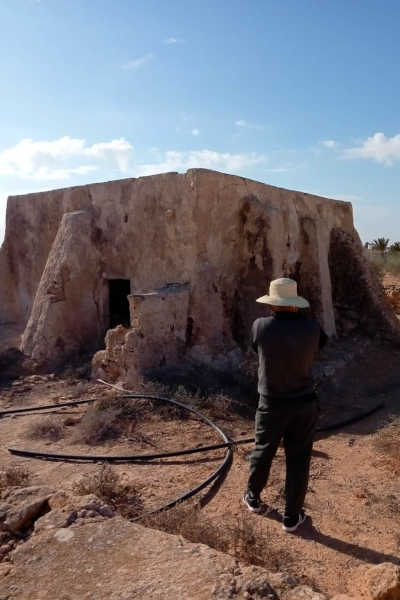
Safouane Tlili documenting the Maariss Mosque
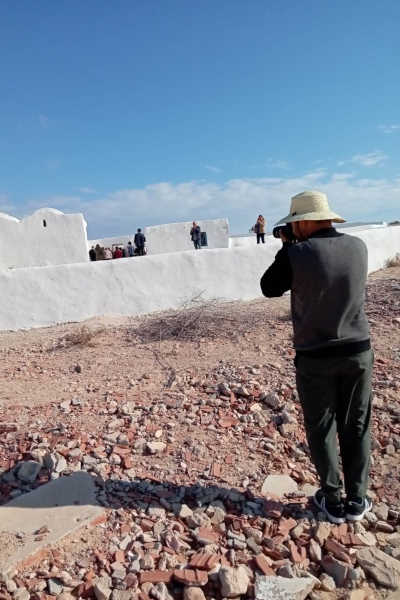
Safouane Tlili documenting the al-Bardawi Mosque
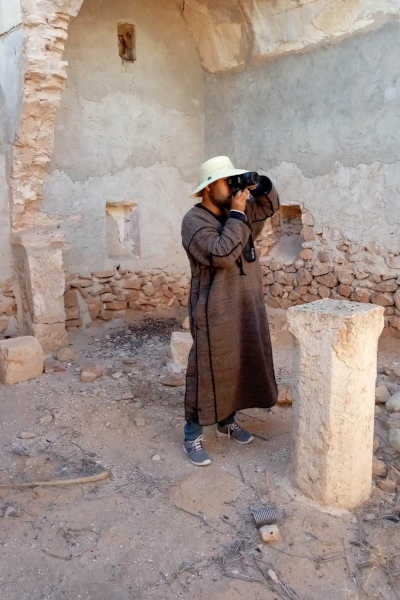
Documenting for photogrammetry an Ibadi mosque in Djerba
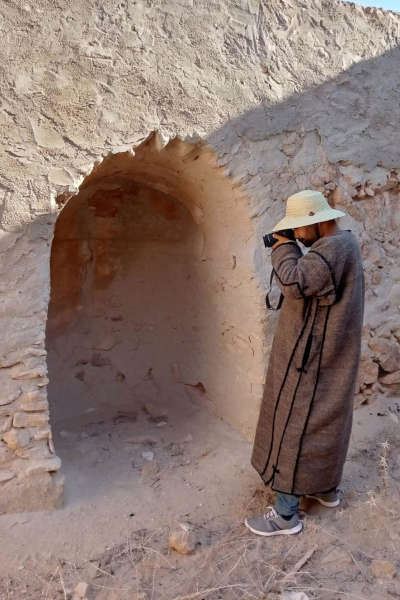
Documenting for photogrammetry an Ibadi mosque in Djerba
The ASOR documentation project has enabled me to expand research that began more than a decade ago. I began tracing the history, elements, political fluctuations, and evolution of the Ibadi mosques long ago using bibliographic references, maps, and speaking with friends. Since my youth, I wanted to decipher the innumerable secrets of these structures. I started to unlock their mysteries by documenting the mosques meticulously through notes and photographs. With the geospatial tools that I and other team members gained in the ASOR project, I was able to document the mosques in a more scientific, accurate, and professional manner. In addition to locating the geographic points using KoboToolbox, the ASOR team provided training in photogrammetry techniques where I (and other implementers from Djerba) learned the best strategies for 3D photo capturing and processing. With this new technology, I discovered details that were not previously visible to (my) naked eye. Armed with this new expertise and technology, I have become convinced that this documentation will help to highlight these important architectural features of cultural heritage.
For me, the photogrammetry documentation guaranteed the perennial preservation of Ibadi mosques despite their destruction caused by time, nature elements, or vandalism. Indeed, documentation is the best way to preserve these mosques from total disappearance, as most are today abandoned and in a state of ruin or degradation due to the absence of periodic maintenance and restoration. Through this documentation, I hope to make available important archival documents to local and international researchers who can use these photos and 3D models in their research on the Ibadi mosques.
This documentation can also be of help for future restoration projects by providing the original architectural plans. The detailed plans will prevent any distortion and error. In regions that witness instability and transformations, possibly affecting the integrity or the existence of the mosques, having a permanent digital copy of these structures available to researchers or visitors will ensure the survival of these important religious and worship abodes. With photogrammetry and KoboToolbox, our team in Djerba was able to build a searchable database that was then plotted on a map using QGIS. ASOR provided professional training and guidance on using these programs. My hope is that this interactive map (even available on any phone as a layer on Google Maps) will facilitate visits to the Ibadi mosques. These visits may be virtually or in-person, and they will allow everyone to discover this important part of the Tunisian heritage.
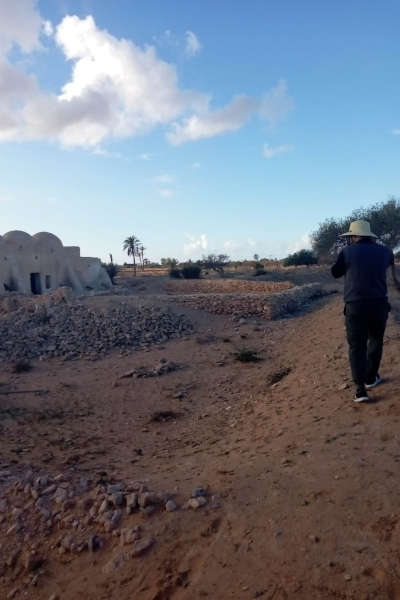
Documenting for photogrammetry the al-Maazouzin Mosque
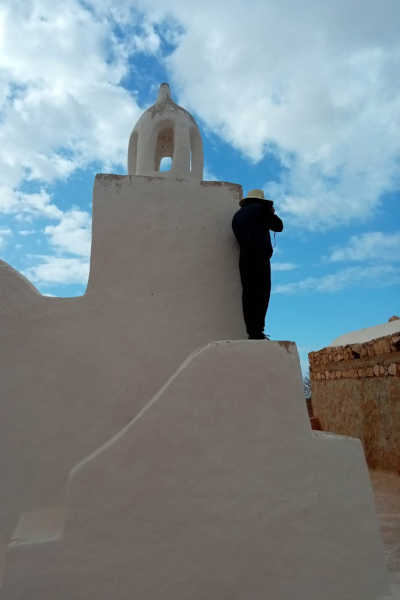
Documenting for photogrammetry the Moro Mosque
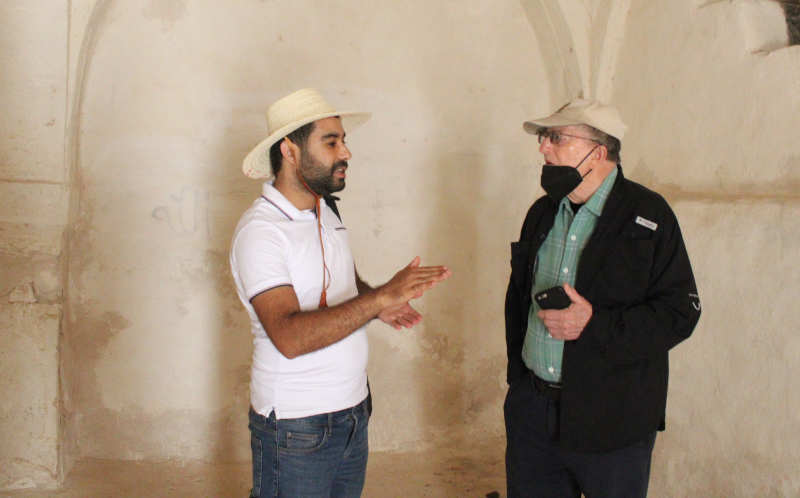
Safouan Tlili and Prof. Jack Sasson from the ASOR delegation inside the Sidi Yati Mosque in Guellala
In an effort to broaden appreciation of this past, our team collected photographs of religious landmarks (Ibadi, Jewish, Christian, and other groups), and we created a photographic exhibition that was launched publicly on May 9, 2023. This exhibition coincided with an annual Jewish pilgrimage to Djerba at the time of the Lag B’Omer Festival. This in-person photo exhibit will be followed in the future by a virtual show, which the tech team is now working on. Pictures of these unique mosques draw attention to specific architectural elements such as minarets styles, sills of different sizes, prayer pulpits, domes, and mihrabs.
In my part of the exhibition, I made a point to highlight the diversity of mosques styles. I included photos of well-preserved or restored mosques as well as examples of mosques in a state of ruin or collapse. This was intentional to make the visitor aware of the urgent need for collective action to preserve those endangered worship and religious places. It is my hope that this exhibition will attract the attention of individuals, associations, organizations, and specialized institutions working in cultural and ecotourism circuits, who can help promote their cultural value more broadly. Some abandoned mosques could serve as excellent museums or as the headquarters for cultural associations. We need to find a way for their continued use if we are to ensure that they will receive much-needed periodic maintenance.
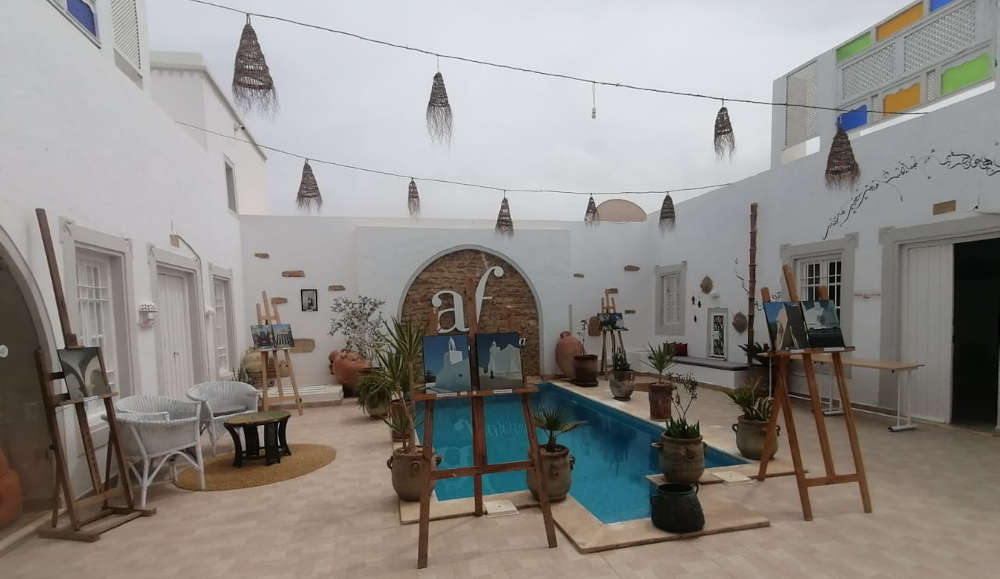
Exhibition of photos of Ibadi and Jewish religious heritage sites
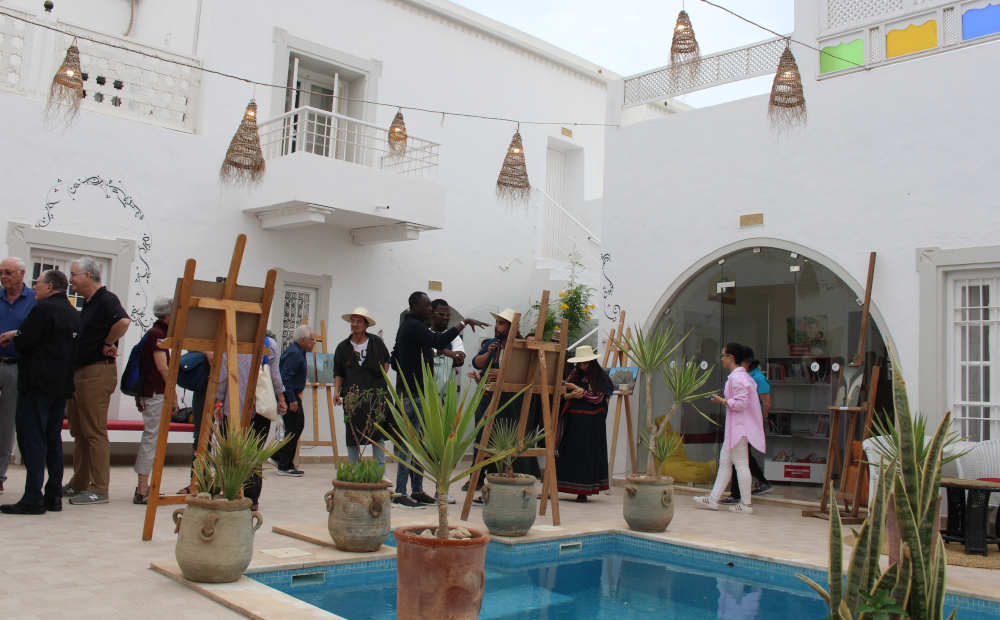
The ASOR delegation visits the exhibit at the Alliance Française
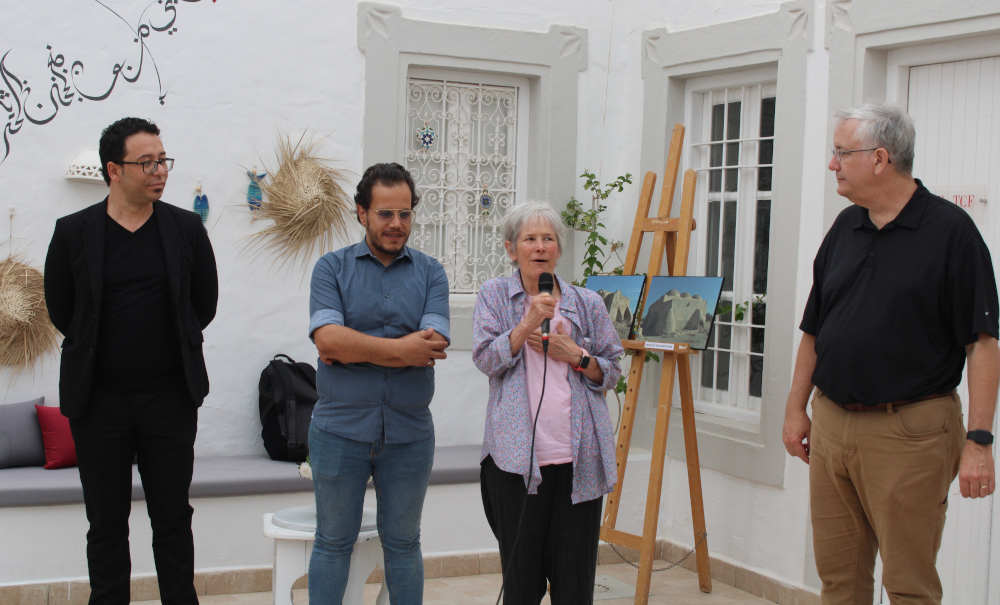
Sharon Herbert, ASOR President, welcomes attendees at the exhibition of photos of Ibadi and Jewish religious heritage sites
This exhibition was not limited in its content to highlighting the Ibadi architectural heritage, but also included photographs of Christian churches and Jewish synagogues on the island of Djerba. For example, the Ghriba Synagogue is widely considered to be the oldest synagogue in Africa. It was a gathering of different religions and minorities in one place, and it splendidly reflected the image of Djerba as a global example of coexistence and acceptance, a place that provides a lesson in plurality for all humanity.
This photographic exposition on May 9 was launched with an interesting folkloric music show by the drumming band Satta Jumaa. This musical troupe is famous for its artists of sub-Saharan origins and attractive performances. The exhibition provided an opportunity for visitors and participants from various minorities and religious communities to spend an enjoyable evening with the members from other parts of Tunisia and with international guests from the ASOR delegation. There were specialists in religious studies and archaeology in attendance. Following the musical performance and viewing of the photographs, the audience engaged in lively discussions and rich interactions, exchanging opinions about the similarities and differences in religions and practices.
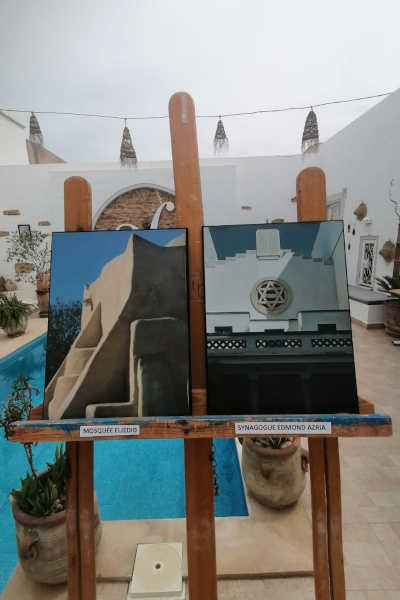
Photos of the al-Jadid Mosque (left) and Azria Synagogue (right)
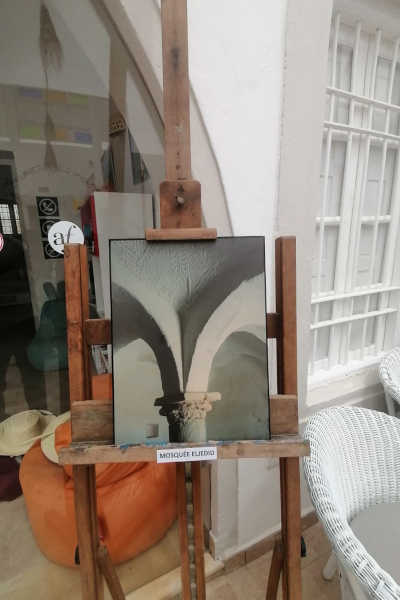
Arcs of the al-Jadid Mosque displaying Amazigh motifs
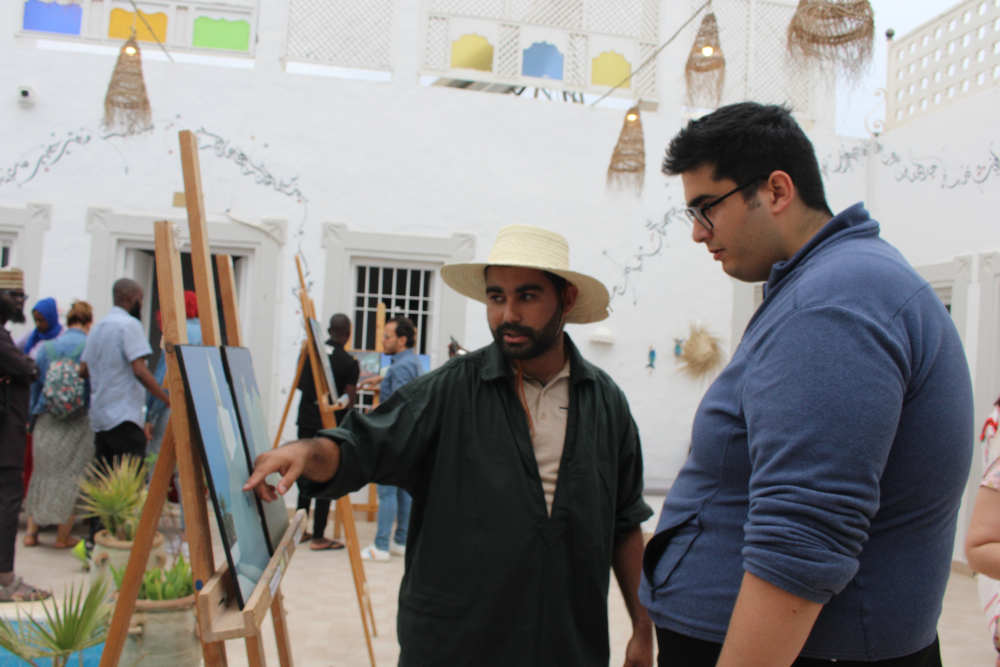
ASOR implementing partners, Safouane Tlili (left) and Golan Wazan (right), examining the photos in the exhibition
This event, and the visits to other religious sites the following day (May 10), allowed me personally to get more closely acquainted with Judaism through the many questions I asked the Jewish youth who contributed photos to this exhibition. I also learned about Christianity through the Western foreigners who visited the exhibit and about Sub-Saharan Islam from implementers from the Sahel working with ASOR on a mirror project in Burkina Faso, Niger, and Mali. This display and event also provided an opportunity to taste many authentic Tunisian sweets, which won the admiration of the attendees.
Indeed, such an exhibition, in its comprehensiveness, is a pioneering model experiment in proving, emphasizing, and celebrating noble human values and in bringing together art productions from local active youth representing different groups and minorities who energetically militate to get to know each other more and to establish peaceful relations, all in the spirit of love and openness.
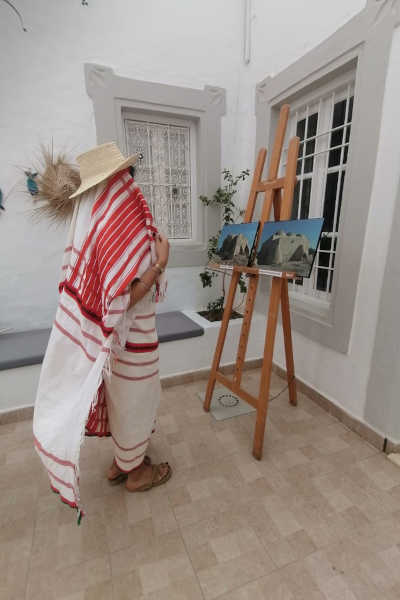
Nada Gammoudi, an ASOR implementing partner, in traditional Djerbian dress, admires photos taken by Safouane Tlili and Benyahou Hadad.
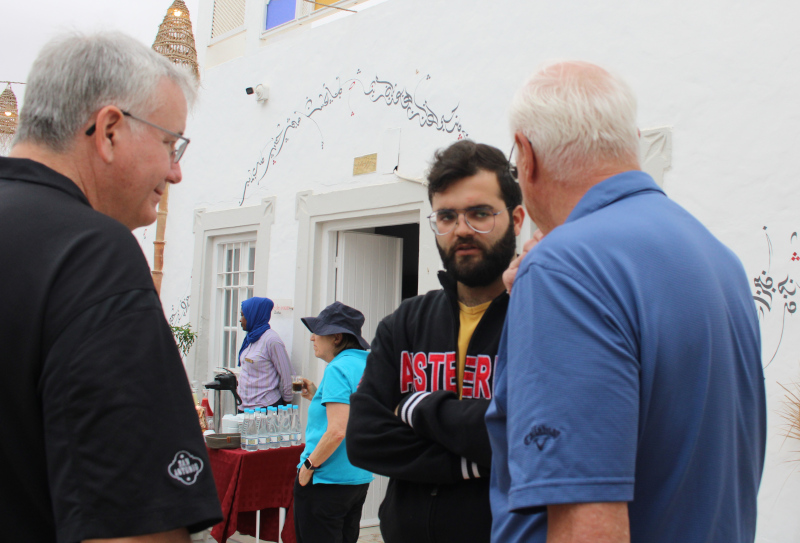
Benyahou Hadad, an ASOR implementing partner, explains to Andy Vaughn, ASOR Executive Director, and Prof. Eric Meyers, ASOR Trustee, the distinct Jewish heritage of Djerba
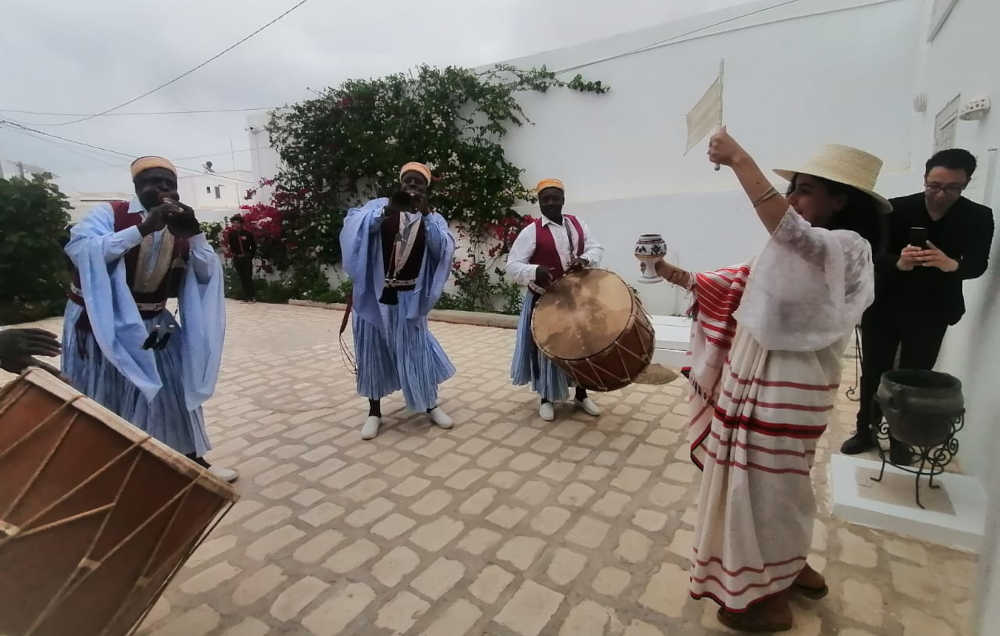
A performance by the band Satta Jumaa launched the photo exhibition at the Alliance Française
One should remember that the insular geography of Djerba and the Ibadi defensive ring system played historically an important role in achieving this convivial coexistence. What increases the success of this experience is that this exhibition will be on display at other locations in the various regions of the Republic of Tunisia, allowing other groups to discover the abundant diversity of our country. I thought that it was also striking that my Jewish neighbors learned things about their island home—many of the Djerbian Jews who attended the show were surprised to learn that the island was home to more than 400 mosques. In turn, many Muslims attendees were amazed to learn of the existence of numerous Jewish synagogues other than the world-famous Ghriba Synagogue.
My experience with ASOR has been a qualitative, rich, motivating, inspiring, and educative one. I have received training, encouragement, and a lot of support to acquire the necessary expertise to efficiently appreciate and document tangible and intangible local heritage on the island of Djerba. This is especially important because much of that heritage is threatened. I think that the island of Djerba represents the most complete model incubating this interest in cultural heritage in Tunisia, and I hope that our documentation project will receive even more attention when Djerba joins the UNESCO World Heritage list (it is in the last stages of its registration).
Djerba is a unique inclusive space for diversity and for living in peace, and the ideal space for the will of cohesion, synergy, and fraternity to thrive. This is not unexpected or a surprise for those of us who call the island our home, as Djerba has demonstrated this plurality throughout time. It has a diversity to which we, Djerbians, are still attached, and from which we continue to draw inspiration.
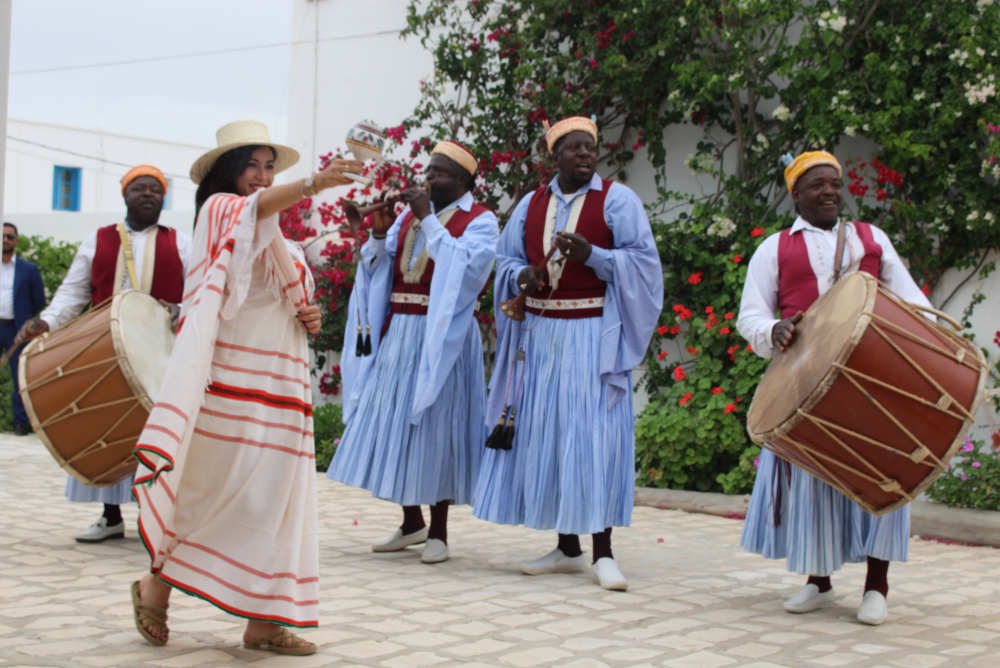
Nada Gammoudi dancing to the music of the drumming band Satta Jumaa
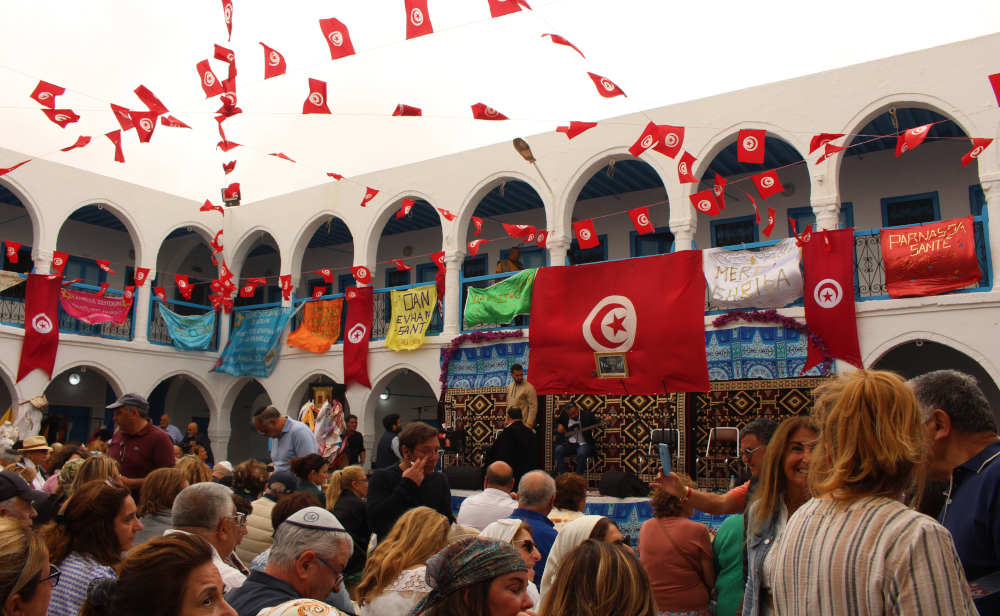
Inside the Ghriba synagogue during the annual Jewish pilgrimage
